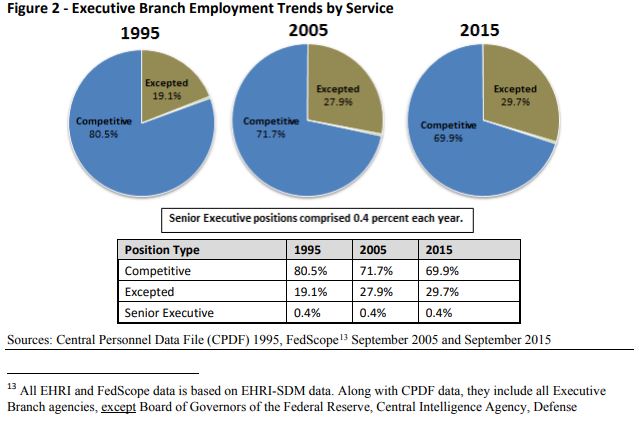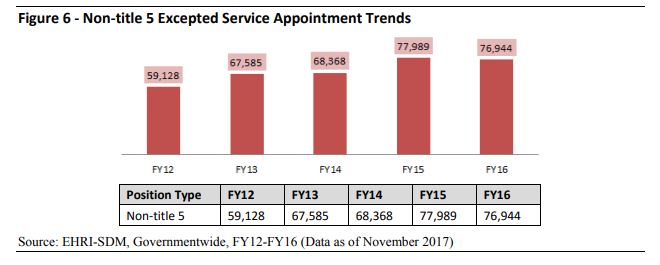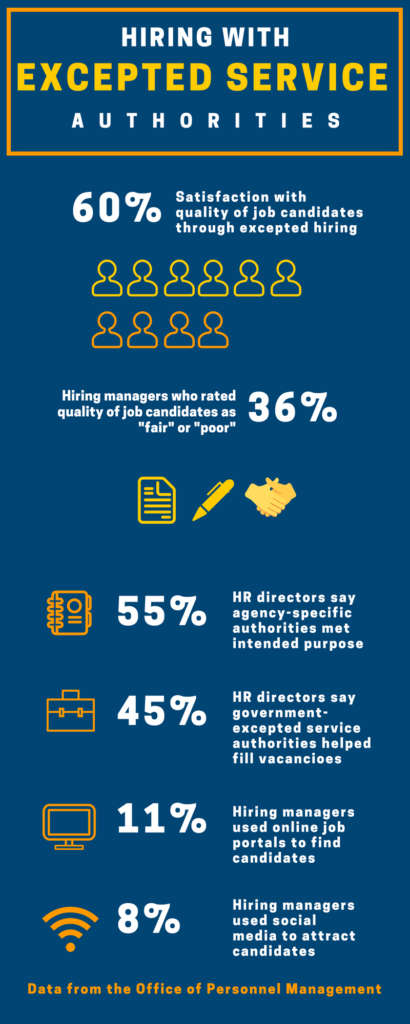
Agencies may have too many special hiring authorities, OPM admits
As agencies gain more specific authorities to hire new employees, the size of the excepted service has grown over the past 20 years, according to a new study from...
Agencies are turning more often to a growing number of hiring authorities to make excepted service appointments to fill mission critical occupations. But federal organizations are often using these authorities as a crutch — not a tool — to be strategic in their hiring practices.
A new study from the Office of Personnel Management found agencies are still confused by the sheer number and variety of authorities they have to make new hires, particularly to the excepted service, which has grown steadily within the past 20 years.
Agencies hired nearly 70 percent of new employees through the competitive hiring process and 30 percent through the excepted service in 2015, compared to a 80-20 percent ratio back in 1995.

OPM hasn’t studied the excepted service since 1973, but in its most recent review, the agency examined hiring actions that took place at 15 other agencies, along with other employee data.
The Government Accountability Office in 2016 found agencies were generally overwhelmed by many options and relied on a small fraction — just 20 out of 105 separate authorities — to hire new employees in 2014.
OPM’s own review of available hiring authorities essentially substantiated the GAO study.
Agencies used 51 of the 62 authorities agencies had available to them over the past five years to make Title 5 excepted service appointments. But they used only 11 of these authorities to make the majority — or 92.3 percent — of excepted service appointments between fiscal 2012 and 2016.
“Agencies may be unaware that some of these authorities exist,” OPM wrote. “However, the non-use and low use of a significant number of excepted service legal authorities suggests it might be useful to explore ways to streamline the current authorities, where appropriate, as they may have become ineffective or obsolete. OPM also found some hiring authorities have similar purposes, which may indicate additional opportunities for streamlining.”
One area that could benefit from some streamlining is the Pathways internship program. Agencies have nine separate authorities to hire college students as interns, but three of those authorities haven’t been used since the program’s creation in 2012, OPM said.
Agencies can use Title 5 authorities, such Schedule A or B authorities that are under OPM’s purview, non-Title 5 authorities or what’s called a ZLM authority, to hire new employees to the excepted service. OPM described a ZLM authority as a “catch-all” term to describe legal authorities based on executive order, regulation or statute.
In recent years, agencies have been using non-Title 5 authorities more often to make excepted service appointments, OPM said.

In addition, veterans preference is also up significantly, according to OPM. Agencies’ use of the veterans recruitment appointment (VRA) authority increased by 59 percent between 2013 and 2016, while their use of the severe physical disability excepted service authorities went up 66 percent during that same period.
Authorities help but could be used more strategically
Though agencies are clearly using these authorities to make more hires to the excepted service, it’s unclear whether federal organizations have truly built these flexibilities into a broader hiring and recruitment plan.
By OPM’s assessment, agencies are still “missing an opportunity to implement more strategic, innovative and targeted recruitment activities to reach highly qualified applicants.”
Most human resources directors and practitioners said agency-specific and governmentwide excepted service hiring authorities served “their intended purposes” and helped fill vacancies for mission critical occupations.
But agency HR specialists said the excepted service hiring process still needs work. Few HR professionals have received training about these excepted service hiring authorities and many expressed a desire for more guidance on their options, OPM said.
“The overall low number of responses regarding training of any kind is a concern, given the
complexities and nuanced nature of excepted service hiring,” OPM wrote. “For example, despite perceptions that, overall, excepted service guidance and training are sufficient and helpful, many comments shared by hiring managers point to a need for clarification on existing guidance.”
And though 60 percent of hiring managers told OPM they were satisfied with the quality of candidates they received through excepted service hiring authorities, 36 percent rated the quality of applicants as “fair” or “poor.”
OPM said agencies need to first fully understand each hiring authority and then create a strategy to more actively communicate and collaborate with prospective job applicants and candidates. Much of the private sector is using Twitter and LinkedIn to find and recruit candidates, OPM said, but few agencies are.
Just 11 percent of agency hiring managers said they used online job portals other than USAJOBS.gov to find possible candidates, and 8 percent said they used social media to attract candidates, according to OPM.
OPM said it plans to issue new guidance on using social media to promote open jobs and engage with prospective candidates.
Copyright © 2025 Federal News Network. All rights reserved. This website is not intended for users located within the European Economic Area.
Nicole Ogrysko is a reporter for Federal News Network focusing on the federal workforce and federal pay and benefits.
Follow @nogryskoWFED
Related Stories

Why direct-hire authority isn’t enough to resolve VA’s staffing shortages




